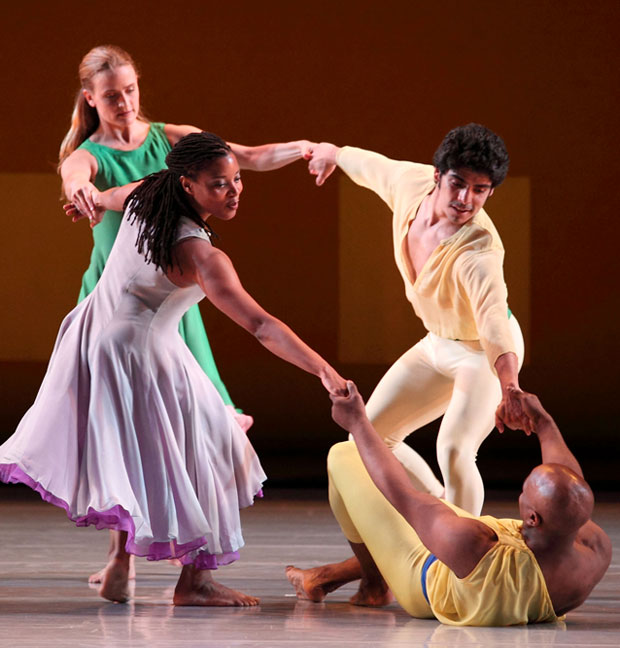
Mark Morris Dance Group
L’Allegro, Il Penseroso ed Il Moderato
Washington, Kennedy Center Opera House
January 26-28, 2012
markmorrisdancegroup.org
A triumph of the artistic imagination, Mark Morris’s L’Allegro, Il Penseroso ed Il Moderato is grand in scale and emotion. This evening-long dance, which unfolds in two acts, is a breathlessly exciting piece choreographed for 24 dancers and set to George Frederic Handel’s 1740 oratorio of the same title.
It has been more than 13 years since this modern dance masterpiece graced the stage of the Kennedy Center. That is why seeing the Mark Morris Dance Group (MMDG) in this dynamic and genuinely uplifting work at the Opera House in January was both a pleasure and a rare treat.
Morris has a passion for Baroque music, so it’s not surprising that he fell in love with the enchanting Handel score. “I knew I wanted to make the dance the moment I heard it,” the choreographer once confessed.
At the heart of the oratorio are two pastoral odes by English poet John Milton (1608-1674), the cheerful “L’Allegro” and the contemplative “Il Penseroso.” To create a bridge between Milton’s joyful and meditative poetic moods, Handel’s librettist Charles Jennens added a third part, the restrained “Il Moderato.” For his dance, Morris rearranged the original score, dropping most of the moderato section and adding an overture, Handel’s Concerto Grosso in G Major.
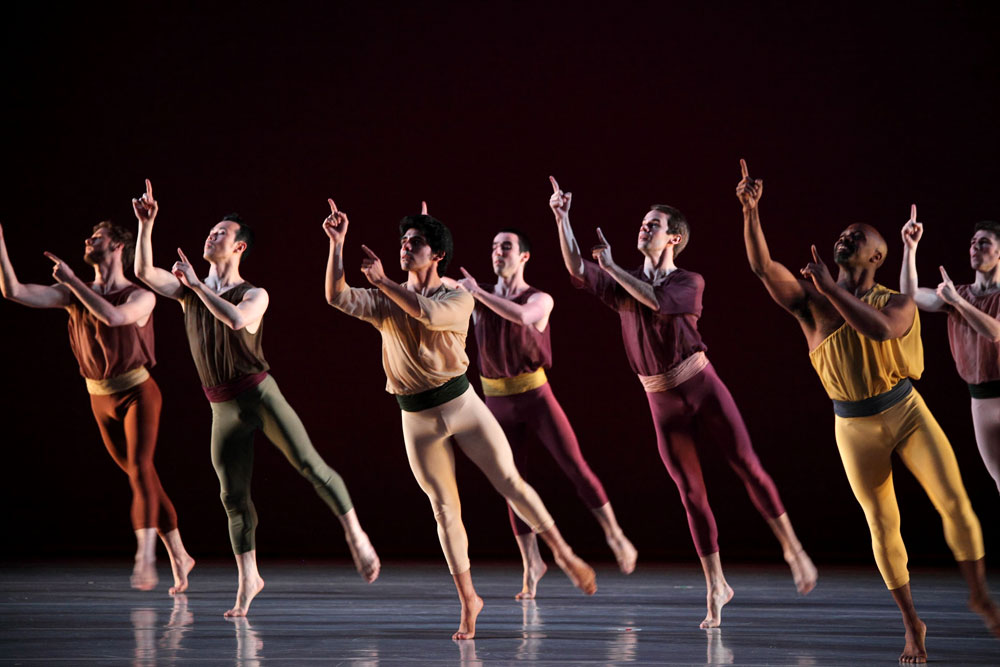
Morris created L’Allegro in 1988, during a peculiar time of his choreographic career. From 1988 to 1990, the then-32-year-old Morris found himself in Brussels as director of dance at the Théâtre Royal de la Monnaie, Belgium’s state opera house. His company was temporarily renamed the “Monnaie Dance Group/Mark Morris” to perform as a resident dance company there. Under a generous three-year contract, fully funded by the Belgian government, Morris and his troupe were given salaries and had at their disposal ample rehearsal space, a full-size orchestra and chorus, and one of the most prominent performance stages in Europe. (It’s said that Morris, who thrives on risk, at first, hesitated about his move to Belgium, wondering if the security of a permanent home would diminish his creativity; but at the end, the offer was too incredible to resist.)
During the Belgian period, Morris outdid himself as a dancemaker. His L’Allegro, the first dance he created and premiered at the Monnaie Theater, was instantly and unanimously proclaimed a masterwork by the critics and the public alike. (Another large-scale magnum opus had followed – Dido and Aeneas – a dance adaptation of Henry Purcell’s 1689 opera of the same title, in which Morris himself originated the dual roles of Dido, Queen of Carthage and her alter-ego, the evil Sorceress.)
It’s not easy to bring L’Allegro onstage, for it commands unusually extensive resources. At the Kennedy Center performance, the augmented MMDG (six dancers were added to the troupe’s regular roster) was supported by the Opera House orchestra, the Washington Bach Consort Chorus, and the four soloists – sopranos Lisa Saffer and Christine Brandes, tenor John McVeigh, and baritone Thomas Meglioranza. The stage design consisted of 21 solid-colored panels and translucent drops, designed by Adrianne Lobel and skillfully lit by James Ingalls. The panels, with their own choreography, created a unique atmosphere for Morris’s dance, rising and falling at certain times during the performance and giving the stage various dimensions and a unique tone to each scene. There were about 50 costumes in various solid colors designed by Christine Van Loon for the cast: chiffon dresses for the women and tunics and tights for the men. The first act was performed in earth-colored attire with a predominantly brown, dark-green, and burgundy palette; but as the dance progressed, more and more dancers were wearing brightly-colored costumes, giving a celebratory mood to the choreography.
Watching L’Allegro is a fascinating and exhilarating experience: The dance completely pulls the audience in for its extraordinary choreographic imagery. Throughout the piece, which is loosely divided into 32 scenes, the movements hardly ever stop. Scenes seamlessly stream into scenes, as arias flow into arias. With an amazing pictorial inventiveness, Morris created all the pastoral imagery of the Milton poems, using only the dancers and bare stage.
When Milton’s lyrics mentioned the lark in his flight, whose “singing startles the dull night,” the little bird actually appeared. Whether he was briskly crossing the stage or just hopping around on one foot, his hands turned like wings, or freezing in a crooked arabesque in a listening pose as if in a moment of respite, Dallas McMurray was captivating and believable in “Male Bird Solo.” He truly relished his part. His performance was so spontaneous you might have thought the dancer was improvising.
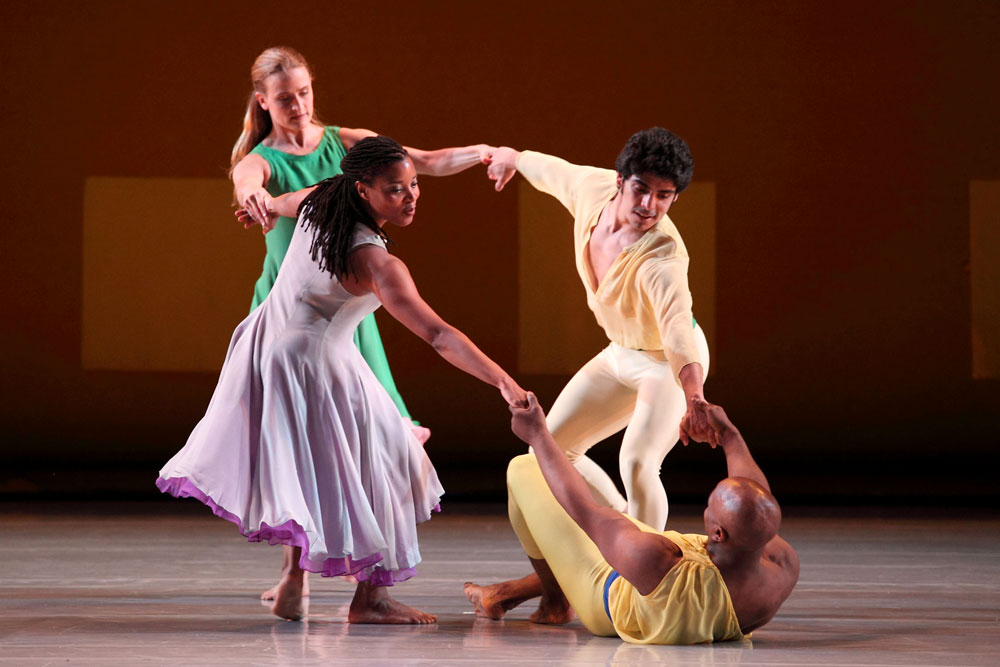
As the chorus sang “To listen how the hounds and horn/Cheerly rouse the slumb’ring morn,” the hunting party took center stage. “The Hunt” was one of the most effective and exciting scenes of the entire piece. The dancers, with humor and poignancy, impersonated not only the hunters, but the horses, dogs, and even the landscape’s trees and bushes.
L’Allegro offers plenty of sheer fun. Take, for example, the all-male number nicknamed “The Stupid Men’s Dance,” which can come across as a hilarious, slapstick romp. It starts as a round dance for six male couples, in which the men embrace, then slap one another in the face, then reconcile and do a little happy circle dance as couples, then spank one another and start over again with perfect timing and aplomb. Judging by the reaction of the audience at the opening night performance, this little circle dance proved a hit in its own right.
The most breathtaking moments of L’Allegro, however, are the large ensemble scenes, with all 24 dancers taking the spotlight. Whether they are whirling in circles or strolling onstage holding onto each other’s elbows, forming amazing linear patterns, the choreography not only reflects the music and the mood of the poetry, but also the ways people relate in life, revealing a genuine human camaraderie and accentuating the immense power of the community.
It’s hard to top Morris’s dancers for spontaneity, dramatic force, and exhilarating energy. On opening night, the dancing was nothing less than brilliant: From the opening “Mad Crossing” to the concluding “Finale,” the cast commanded the stage, dancing with sheer joy and élan, compelling the audience at the end of the performance into a thunderous standing ovation.







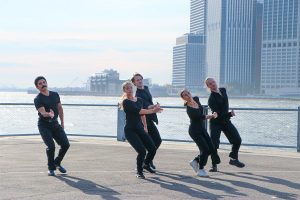
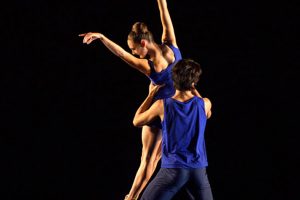




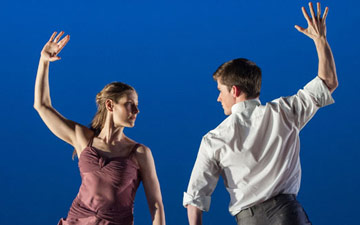


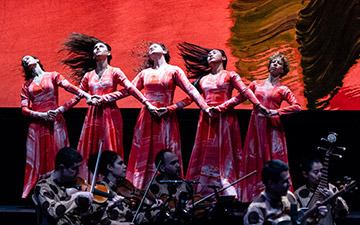
You must be logged in to post a comment.